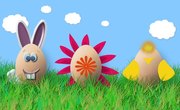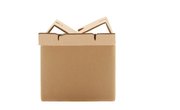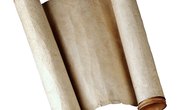Vocabulary is critical to all other learning, but mastering vocabulary can be a struggle for many students. To help students succeed, teachers must choose engaging learning experiences. One vocabulary learning strategy is the use of graphic organizers, diagrams that help students make sense of information. You can draw on paper to make flat graphic organizers, or liven up the display by making 3-D flipbooks to engage students and help them retain vocabulary.
Simple Flipbook
Create vocabulary flipbooks with information about each word such as a teacher definition, student definition, example, picture and a sample sentence. With a large square piece of paper, even young elementary students can independently make a simple flipbook. Have students fold the square diagonally, bringing opposite corners together, into a triangle. Repeat the process with the other corners. Students then fold each corner in to the center of the square where the folds intersect, creating four flaps. Guide students through placing a word on each outer flap and the desired vocabulary information under the flap.
Quiz Words Flipbook
With this flipbook, students can play a quiz game after completing the work. Provide students with a large, rectangular piece of construction paper and plain index cards. Instruct them to fold each index card in half across the shorter side. On the outside of the folded card, students write the word. On the inside, students write the definition and any other teacher-required information. Have students fold the large construction paper in half and write "Quiz Words" on it, creating a folder for the game. Students open the construction paper and then glue all the folded index cards on it with each word facing up. To play the game, students take turns picking a word to define and then checking the definition underneath. If correct, they get a point.
Layered Flip Book
A layered vocabulary flipbook can hold any number of words. Because of its format, the pages are slightly larger than most flipbooks, making it a good choice for younger students who often write larger. Use half as many sheets of paper as the number of words you have. Place the paper in a stack then spread it out slightly so that the tops of the papers are staggered, the top of each page down about 1/2 inch from the top of the one beneath it. Fold the bottom edges up so that the layers from beneath fold over and almost meet the layers from the top. Staple the folded edge. The bottom edges form a layer of tabs on which students can write the vocabulary words. Each page provides a large writing surface where students can write a definition, sentence and example and add a picture.
Shutter Flipbook
Fold a large piece of paper in half across the short width and open it back up. Fold each edge into the fold to form what looks like shutters closing on a window. Each of the shutters on both sides can be cut multiple times to create flaps. On each flap, write a vocabulary word. Underneath the word, students should write a definition in their own words. Next to the definition, students can write a sentence meaningfully using the word.
Related Articles
References
Writer Bio
Elizabeth Stover, an 18 year veteran teacher and author, has a Bachelor of Science in psychology from the University of Maryland with a minor in sociology/writing. Stover earned a masters degree in education curriculum and instruction from the University of Texas, Arlington and continues to work on a masters in Educational Leadership from University of North Texas. Stover was published by Creative Teaching Press with the books "Science Tub Topics" and "Math Tub Topics."











